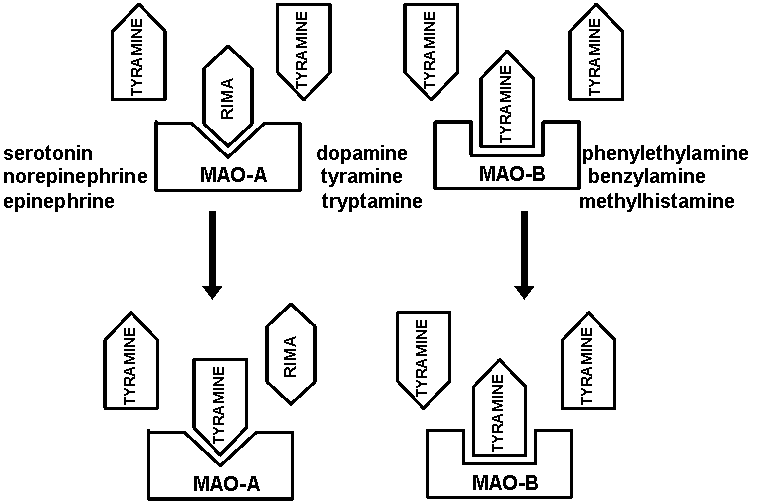Psychopharmacology is very extensive branch of medicine. This chapter will emphasize basic pharmacological concepts of action of antipsychotics and antidepressants only. The reader should consult standard reference sources for more information from psychopharmacology.
Psychotropic drugs are amphiphilic molecules frequently; i.e. they are soluble both in the water phase and in the lipid bilayer. Amphiphilic drugs rapidly permeate through plasma membrane and/or accumulate in hydrophobic interior of lipid bilayer (Figure 3.1), so, interactions are possible both with membrane macromolecules and with cytoplasmatic or nuclear molecules.
Central nervous system drugs act primary as agonists or antagonists of neurotransmitter receptors, inhibitors of regulatory enzymes or blockers of stimulators of neurotransmitter membrane transporters (Table 3.1). Classification psychotropic drugs according to effects on mental functions are shown in Table 3.2.
Figure 3.1. Interaction of amphiphilic drugs with membrane
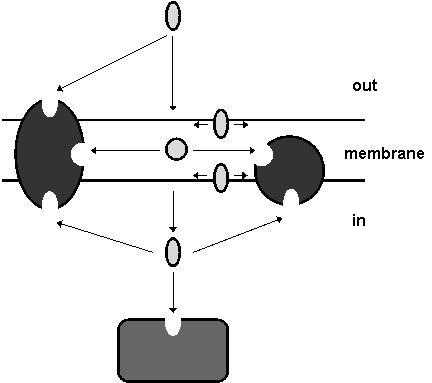
Table 3.1. Potential action of psychotropics
|
1. synthesis and storage of neurotransmitter |
|
2. releasing of neurotransmitter |
|
3. receptor-neurotransmitter interactions (blockade of receptors) |
|
4. catabolism of neurotransmitter |
|
5. reuptake of neurotransmitter |
|
6. transduction element (G protein) |
|
7. effector system |
Table 3.2. Classification psychotropics according to effects on mental functions
|
parameter |
effect |
group of psychotropics |
examples |
|
watchfulness (vigility) |
positive |
psychostimulant drugs |
amphetamine, amphetaminile, ephedrine, fenmetrazine, mazindole, mezokarb, pemoline, methylphenidate |
|
negative |
hypnotic drugs |
barbital, amobarbital, hexobarbital; glutethimid, metachalone, clomethiazol; nitrazepam, flunitrazepam, triazolam; zopiclone, zolpidem |
|
|
affectivity |
positive |
antidepressants |
imipramine, desipramine, amitriptyline, nortriptyline, clomipramine, maprotiline, citalopram, fluoxetine, fluvoxamine, mianserine, buspirone, moclobemide, Li+ |
|
anxiolytics |
guaifenezine, meprobamate; diazepam, alprazolam, oxazepam; neuroleptics and antidepressants |
||
|
negative |
dysphoric drugs |
reserpine, clonidine, a-methylDOPA |
|
|
psychic integrations |
positive |
neuroleptics, atypical antipsychotics |
thioridazine, chlorpromazine, chlorprotixene, levopromazine, haloperidol, perfenazine, clozapine, amisulpride, risperidone, sertindole, quetiapine, olanzapine |
|
negative |
hallucinogenic agents |
lysergid, cocaine, amphetamines, ketamine, hashish, marihuana, phencyclidine, mescaline |
|
|
memory |
positive |
nootropics |
piracetam, pyritinol, meclophenoxate |
|
negative |
amnestic drugs |
anticholinergics |
(See: vestka J. a kol.: Psychofarmaka v klinické praxi. GRADA Publishing, 1995; Hynie S.: Psychofarmakologie v praxi. Galén, 1995.)
3.1. Antipsychotics
Antipsychotics are divided into two groups (Table 3.3):
- Conventional antipsychotics (basal or incisive)
- Atypical antipsychotics
Incisive antipsychotics have high affinity to D2 receptors and low affinity to other types of receptors. They affect positive symptoms of schizophrenia mainly. They bring about extrapyramidal symptoms (EPS).
Basal antipsychotics have lower affinity to D2 receptors and higher affinity to other receptor types beside incisive antipsychotics. They affect positive and affective symptoms of schizophrenia. They have sedative effects, they bring about anticholinergic, antihistaminic and cardiovascular side effect, and extrapyramidal symptoms are less frequent.
Atypical antipsychotics (serotonin-dopamine antagonists) are antagonists of D2 and serotonin 2A receptors, but they can affect many other types of receptors (Table 3.5). They are much more efficient in treatment of negative symptoms of schizophrenia in comparison with conventional antipsychotics. Atypical antipsychotics have lower side effects (lower EPS or tardive dyskinesis)
Table 3.3. Classification of antipsychotics
|
group |
examples |
|
|
conventional antipsychotics (classical neuroleptics) |
basal (sedative) antipsychotics |
chlorpromazine, chlorprotixene, clopenthixole, levopromazine, periciazine, thioridazine |
|
incisive antipsychotics |
droperidole, flupentixol, fluphenazine, fluspirilene, haloperidol, melperone, oxyprothepine, penfluridol, perphenazine, pimozide, prochlorperazine, trifluoperazine |
|
|
atypical antipsychotics (antipsychotics of 2nd generation) |
amisulpiride, clozapine, olanzapine, quetiapine, risperidone, sertindole, sulpiride |
|
(See: vestka J.: Nová (atypická) antipsychotika 2. generace. Remedia 9, 366-385, 1999.)
Table 3.4. Mechanisms of action of antipsychotics
|
conventional antipsychotics |
ˇ D2 receptor blockade of postsynaptic in the mesolimbic pathway |
|
atypical antipsychotics |
ˇ D2 receptor blockade of postsynaptic in the mesolimbic pathway to reduce positive symptoms; ˇ enhanced dopamine release and 5-HT2A receptor blockade in the mesocortical pathway to reduce negative symptoms; ˇ other receptor-binding properties may contribute to efficacy in treating cognitive symptoms, aggressive symptoms and depression in schizophrenia |
Table 3.5. Receptor systems affected by atypical antipsychotics
|
risperidone |
D2, 5-HT2A, 5-HT7, a1, a2 |
|
sertindole |
D2, 5-HT2A, 5-HT2C, 5-HT6, 5-HT7, D3, a1 |
|
ziprasidone |
D2, 5-HT2A, 5-HT1A, 5-HT1D, 5-HT2C, 5-HT7, D3, a1, NRI, SRI |
|
loxapine |
D2, 5-HT2A, 5-HT6, 5-HT7, D1, D4, a1, M1, H1, NRI |
|
zotepine |
D2, 5-HT2A, 5-HT2C, 5-HT6, 5-HT7, D1, D3, D4, a1, H1, NRI |
|
clozapine |
D2, 5-HT2A, 5-HT1A, 5-HT2C, 5-HT3, 5-HT6, 5-HT7, D1, D3, D4, a1, a2, M1, H1 |
|
olanzapine |
D2, 5-HT2A, 5-HT2C, 5-HT3, 5-HT6, D1, D3, D4, D5, a1, M1-5, H1 |
|
quetiapine |
D2, 5-HT2A, 5-HT6, 5-HT7, a1, a2, H1 |
NRI - norepinephrine reuptake inhibitor, SRI serotonin reuptake inhibitor
(See: Stahl S.M.: Psychopharmacology of Antipsychotics, Martin Dunitz, London, 1999.)
3.2. Antidepressants
Molecular mechanisms of action of antidepressants are much more diverse than that of antipsychotics. Classification of antidepressants based on their acute pharmacological actions is shown in Table 3.6. Antidepressants are amphiphilic molecules; so, they easy permeate through the cell membrane and may affect molecules on the outer and inner membrane surface, cytoplasmic elements and nuclear molecules (Figure 3.2).
Table 3.6. Classification of antidepressants based on acute pharmacological actions
|
inhibitors of neurotransmitter catabolism |
monoamine oxidase inhibitors (IMAO) |
|
reuptake inhibitors |
serotonin reuptake inhibitors (SRI) norepinephrine reuptake inhibitors (NRI) selective SRI (SSRI) selective NRI (SNRI) serotonin/norepinephrine (dual) inhibitors (SNRI) norepinephrine and dopamine reuptake inhibitors (NDRI) serotonin 2A antagonist/reuptake inhibitors (SARI) |
|
agonists of receptors |
5-HT1A |
|
antagonists of receptors |
a2-AR, 5-HT2 |
|
inhibitors or stimulators of other components of signal transduction |
G proteins, adenylyl cyclase (AC), phospholipase (PL), protein kinase (PK), phosphatase, ATPase, phospholipid dependent proteins, transcription factors, 2nd a 3rd messengers |
Therapeutic response is observed after a few weeks of antidepressant treatment; so, many adaptive changes in cellular functions occur. The neurotransmitter receptor hypothesis of antidepressant action explains the ultimate mechanism of their therapeutic action by receptor sensitivity changes. Currently, there is focus on the gene expression that is activated by antidepressants (see Chapter 5).
Figure 3.2. Potential mechanisms of antidepressants action
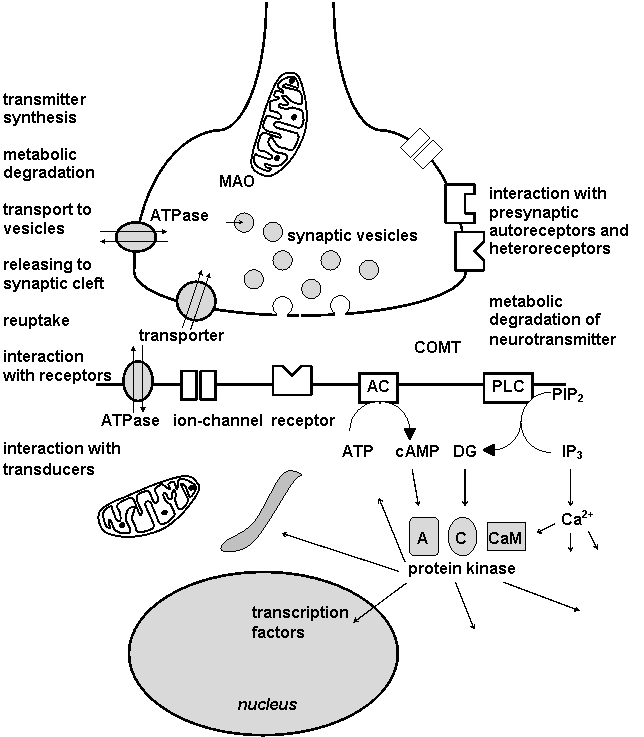
Table 3.7. Examples of antidepressants
|
group |
subgroup |
examples |
|
tricyclic (thymoleptics) |
activating |
desipramine, nortriptyline, protriptyline, dosulepine |
|
sedative, anxiolytic |
imipramine, amitriptyline, trimipramine, clomipramine |
|
|
II. a III. generation |
II. generation - activating |
viloxazine, buspirone, amineptine, maprotiline |
|
II. generation - sedative, anxiolytic |
mianserine, trazodone, nefazodone, pirlindol |
|
|
III. generation - SSRI |
citalopram, fluvoxamine, fluoxetine, sertraline, paroxetine |
|
|
enhancing 5-HT uptake |
tianeptine |
|
|
MAO inhibitors |
nonselective irreversible |
phenelzine, tranylcypromine, isocarboxazid |
|
selective MAOI-B irreversible |
deprenyl |
|
|
selective MAOI-B reversibile |
|
|
|
selective MAOI-A irreversible |
|
|
|
selective MAOI-A reversible |
moclobemide, brofaromine, toloxatone, amiflamine |
|
|
thymoprophylactics |
|
lithium, carbamazepine, sodium valproate, valpromide |
(See: vestka J. a kol.: Psychofarmaka v klinické praxi. GRADA Publishing, 1995.)
3.3. Mechanism of action of antidepressants
Selective serotonin reuptake inhibitors (SSRI) are the most frequently used antidepressants. Their mechanism of action on serotonergic neuron in a depressed patient is shown on Figure 3.3.
Before treatment (Figure 3.3 A):
- There is relative deficiency of 5-HT in serotonin neurone in a depressed patient.
- Number of serotonin receptors is up-regulated, including presynaptic autoreceptors as well as postsynaptic receptors.
- Releasing of serotonin from synaptic knob can be affected: 1. positively by activity of serotonin transporter or by tryptophan (serotonin precursor) availability; 2. negatively by activation both presynaptic inhibitory receptors, 5‑HT1B or a2-AR, and somatodendritic receptors, 5-HT1A.
After acute administration of SSRI (Figure 3.3 B):
- A considerable part of serotonin transporters is blocked and serotonin remains for a longer time in extracellular space. This causes serotonin to increase in the somatodendritic area mainly.
- Negative feedback mediated by inhibitory presynaptic and somatodendritic receptors is increased and both frequency of firing of action potentials and amount of serotonin released from presynaptic button is decreased.
After chronic treatment by SSRI (Figure 3.3 C):
- The increased 5-HT at the inhibitory somatodendritic receptors causes them to down-regulate and/or desensitise. It results in increase of frequency of firing of action potentials and in increase of the amount of serotonin released to synaptic cleft. The marked increase of serotonin release in the axon terminal is delayed as compared with the processes after acute administration of SSRI. This delay may explain why therapeutic action of antidepressants is not immediate.
- The increased 5-HT at the axon terminal causes down-regulation and/or desensitization of postsynaptic and presynaptic receptors. This desensitization may mediate the reduction of side effects of SSRI.
Mechanism of action of a2-adrenoceptor blockers is shown on Figure 3.4; mechanism of action of reversible inhibitors of monoamine oxidase A (RIMA) is on Figure 3.5.
Figure 3.3. Mechanism of action of selective serotonin reuptake inhibitors (SSRI)
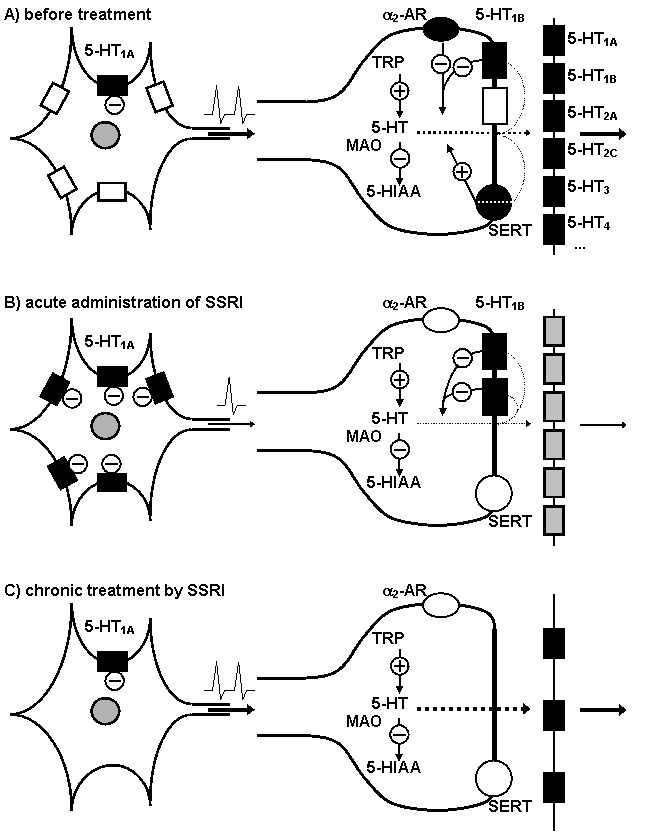
Figure 3.4. Mechanism of action of a2-adrenoceptor blockers
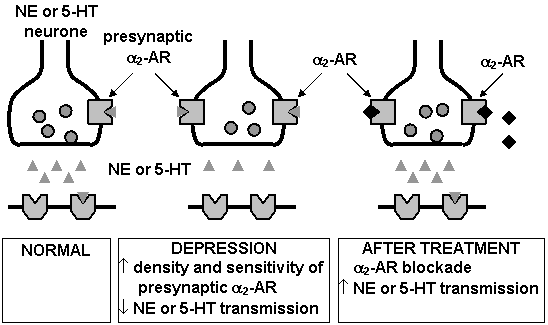
Figure 3.5. Mechanism of action of reversible inhibitors of MAO-A (RIMA)
